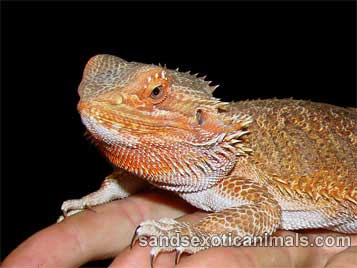
Origin:
Found in the hot, arid regions of Australia.Description:
Bearded dragons are available in a variety of colors. The bearded dragon may reach a length of up to 24 inches with about half of the length made up by the tail. The bearded dragon derives its name from the pointy spines that adorn the throat and ear openings. They can live 7 to 10 years in captivity.Feeding:
Bearded dragons are omnivorous. They feed on a diet consisting of crickets, mealworms and rodents supplemented with vegetables. There are several brands of commercial food also available for them. Hatchlings (up to 3 months old) should be fed a diet of tiny crickets, fruitflies or waxworms daily with finely chopped vegetables being offered 2 to 3 times per week. Juveniles (4 to 18 months old) can have small mealworms and an occasional pinkie added to their diets. Adult bearded dragons should be fed vegetables every other day while being fed insects daily or every other day. Either the vegetables or the insects should be supplemented with calcium. You can sprinkle the vitamins on the vegetables or dust the crickets with calcium. Some of the vegetables that may be used include romaine lettuce, mustard greens, collard greens, spinach and kale.Housing:
An adult bearded dragon requires a minimum of a 40 gallon aquarium. Bearded dragons should have tree limbs in their housing to allow them to climb and bask. They also need hide boxes for a sense of security. They should be provided with a large enough water dish for them to completely immerse themselves. The bearded dragon will use this dish as a drinking fountain, swimming pool and toilet so frequent cleaning is necessary. Heat is an absolute must. Heat may be provided by lamps or undertank heaters. A spot light may be hung above one end of the tank or cage. Light should also be provided through ultraviolet lights such as Vita-lites. Bearded dragons can be housed using aspen pellets or small bark chips. Use a variety of large rocks for basking and to help keep their nails worn down.Temperature:
You should have one end of your tank or cage to be in the daytime temperature range of 90-100 degrees Fahrenheit and the other end to be 80-84 degrees Fahrenheit. Place basking sites in the hot end and hiding places in the cool end. At night temperatures can drop to 65-75 degrees Fahrenheit.
Compliments of:
S & S Exotic Animals, Inc., 1711 Connorvale, Houston, TX 77039 (281) 590-0426
http://www.sandsexoticanimals.com
